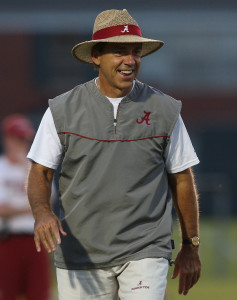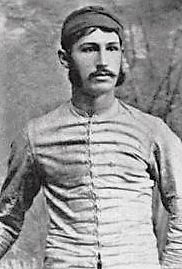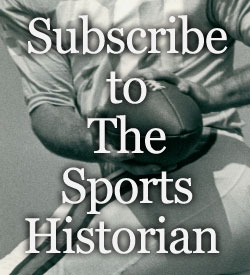How do the current SEC coaches match up with some of the prior coaches at their respective schools? Let’s start the comparisons with Nick Saban, Bret Bielema, Gus Malzahn, Jim McElwain and Kirby Smart. We’ll examine the rest in the near future.
- Nick Saban of Alabama
Saban begins his 10th season in Tuscaloosa. His official record at Alabama is 100-18, a .847 win percentage His teams have won six SEC titles and four national championships. Here are the statistics from two of the more famous Alabama coaches after their ninth seasons in Tuscaloosa:
Frank Thomas—From 1931-1939 Thomas had a record of 69-9-4, an .840 win percentage. During this time he won four SEC titles and two national championships.
Paul “Bear’ Bryant—From 1958-1966 Bryant compiled a record of 80-12-6, an .820 win percentage. Bryant, during this time, won four SEC titles and three national championships.
No other Crimson Tide coaches managed to stay in Tuscaloosa for at least nine seasons. Arguably, Saban is the most successful football coach in Alabama history. Unless something unforeseeable takes place, Saban will remain at Alabama as long as he wants.
- Bret Bielema of Arkansas
Bielema is entering his fourth season as coach of the Razorbacks. His record after three seasons in Fayetteville is 10-15, a .400 win percentage. He has won zero SEC titles and zero national championships.
Arkansas has had 13 coaches who lasted at least three years. Of those 13, Bielema’s win percentage is better than just two. His win percentage does not come close to Arkansas legends Hugo Bezdek, Frank Broyles, Lou Holtz, Ken Hatfield and Houston Nutt. That does not bode well. If Bielema doesn’t win more games over the next couple of seasons, you may see a different coach in 2018 at Arkansas.
- Gus Malzahn of Auburn
Malzahn enters his fourth season on the Plains with a 27-17 record, a win percentage of .610. He has won one SEC title and lost to Florida State in the BCS national championship game after his first season in 2013. Since then, Auburn has been very mediocre.
Thirteen Auburn coaches lasted at least three seasons. Of those 13, Malzahn has a better win percentage than nine. This includes Hall of Fame coaches Mike Donahue and Shug Jordan. A better comparison may be Gene Chizik, the man Malzahn succeeded. Chizek lasted four years. With Heisman-winning quarterback Cam Newton, Chizik won the national championship in his second season, 2010. Two years later, Auburn fired Chizik and hired Malzahn. If Auburn struggles again this season, Malzahn will probably be looking for work elsewhere.
- Jim McElwain of Florida
McElwain enters his second season at Florida after a 10-3 first year and second place finish in the conference. Not a bad start. His win percentage is .770.
The University of Florida has had 24 coaches before McElwain, but let’s compare him with three Hall of Fame coaches, two future Hall of Fame coaches and two coaches who replaced those two future Hall of Fame coaches.
Hall of Famer Charlie Bachman coached Florida from 1928-1932. He was 8-1 his first year and finished with an overall record of 27-18-3. He won no titles of any kind.
Hall of Famer Ray Graves coached Florida from 1960-69 and tallied a 9-2 record his first year. He went on to compile a 70-31-4 overall record with no titles.
Hall of Famer Doug Dickey coached the Gators from 1971-78. He went 7-4 his first year and amassed an overall record of 58-43-2, with no titles.
Future Hall of Famer Steve Spurrier coached Florida from 1990-2001. He accumulated a record of 9-2 his first year. His overall record at Florida was 122-27-1, with six SEC titles and one national championship.
Ron Zook took over the Florida reigns from 2002-2004. Zook finished 8-5 his first year, 23-14 overall, with no titles. He could not match Spurrier’s success.
Future Hall of Famer Urban Meyer took over in 2005 and went 9-3 his first year. He coached through the 2010 season amassing a record of 65-15, with two SEC titles and two national championships.
Will Muschamp replaced Meyers and went 7-6 his first season in 2011. After four years and an overall record of 28-21, with no titles, Florida terminated him.
Florida’s most successful coaches have had very good first seasons, something that McElwain achieved in his first campaign. This bodes well for him, although it is too early to make a prediction of success along the lines of Spurrier and Meyer.
- Kirby Smart of Georgia
Smart starts his first year at Georgia after spending 11 years as an assistant coach under Nick Saban, the last eight as defensive coordinator. Smart has the pedigree to be very successful. Time will tell. Below are first year comparisons to prior Georgia coaches who had success at the school.
Harry Mehre coached the Bulldogs from 1928-1937. His record was only 4-5 his first year, but he ended his Georgia career with a record of 59-34-6, a win percentage of .600. He won no titles at Georgia.
Wally Butts had the helm at Georgia from 1939-1960. In his first year, Butts finished with a losing record of 5-6. However, he ended his UGA career at 140-86-9, a win percentage of .600. Butts won four SEC titles and one national championship while coaching the Bulldogs.
Vince Dooley is the winningest coach at UGA. He coached the Bulldogs from 1964-1988. Dooley finished his first year with a 7-3-1 record and compiled an overall tally of 201-77-10, a win percentage of .700. Dooley’s teams won six SEC titles and one national championship.
Jim Donnan coached at UGA from 1996-2000. He finished 5-6 his first season but amassed an overall record of 40-19, a win percentage of .680. Donnan won no titles while at UGA.
Mark Richt coached at Georgia from 2001-2015 and finished with a record of 8-4 after his first season. His overall record at UGA was 145-51, a.740 win percentage. Richt won two SEC titles but no national championships.
Again, only time will tell as to the overall success of Kirby Smart. Even if for someone reason UGA struggles in 2016, the past has shown that Smart could still have a very successful career at Georgia. However, Smart will always be compared with Richt. While Richt has a terrific win percentage, he could not bring the Georgia fans a national title. Will Smart?
Next time we’ll take a look at Mark Stoops of Kentucky, LSU’s Les Miles, Hugh Freeze of Ole Miss, Dan Mullen of Mississippi State and South Carolina’s Will Muschamp.









